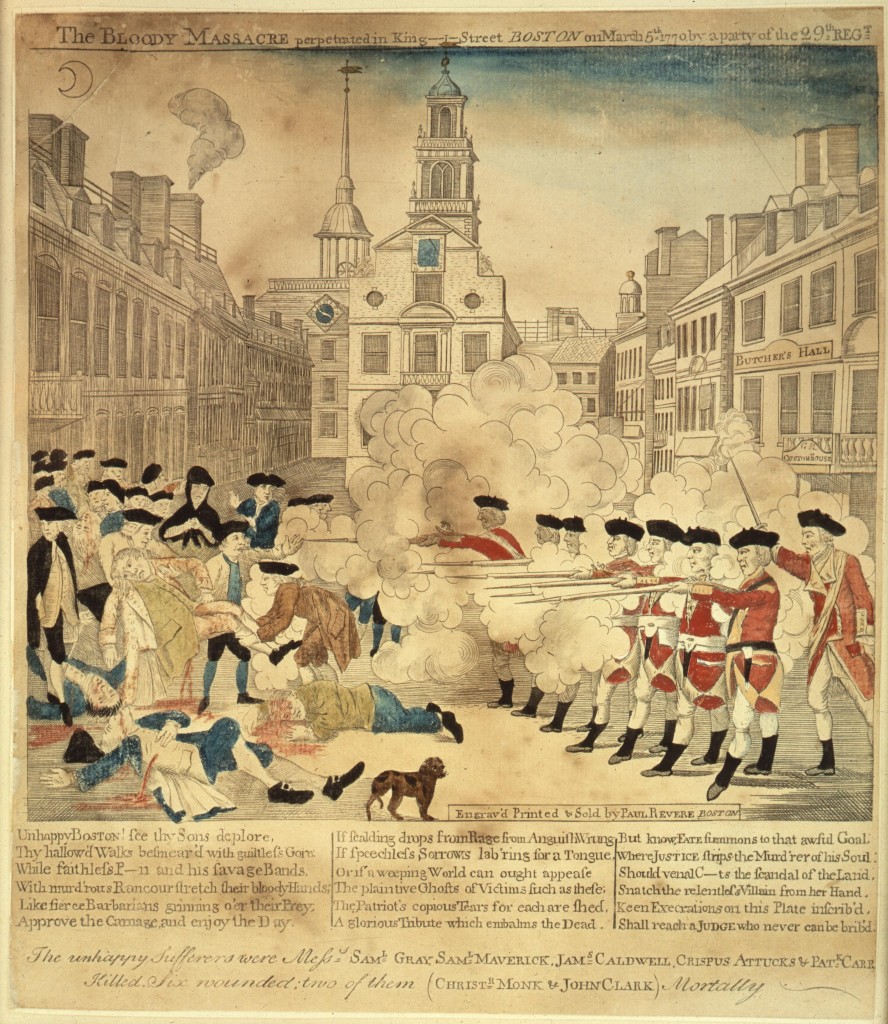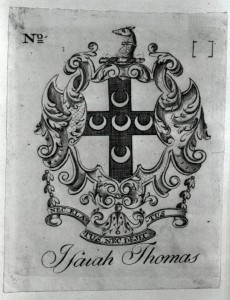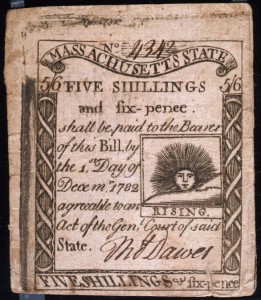 This past April, the state of Massachusetts marked the 235th anniversary of the famous ride of Paul Revere and the start of the American Revolution at the Battles of Lexington & Concord. As you might expect, AAS takes Patriot’s Day (April 19th) seriously. Like most Massachusetts residents, we have the day off (it is a state holiday here) and so our Reading Room was closed. But the week after Patriot’s Day, we were back at work and Babette Gehnrich, our chief conservator, began a conservation survey of our outstanding collection of engravings by Paul Revere. Some prints will be re-matted, others repaired and cleaned, if necessary. Some, if not all of the prints, will be digitized. The hope is to produce an illustrated box list or finding aid this summer which will provide an item level accounting of the Society’s holdings of Revere’s separately published prints. You can currently search for information (but not illustrations) on all of Revere’s engraved prints, including his engraved book illustrations, in the Catalogue of American Engravings (available online at http://catalog.mwa.org:7108/).
This past April, the state of Massachusetts marked the 235th anniversary of the famous ride of Paul Revere and the start of the American Revolution at the Battles of Lexington & Concord. As you might expect, AAS takes Patriot’s Day (April 19th) seriously. Like most Massachusetts residents, we have the day off (it is a state holiday here) and so our Reading Room was closed. But the week after Patriot’s Day, we were back at work and Babette Gehnrich, our chief conservator, began a conservation survey of our outstanding collection of engravings by Paul Revere. Some prints will be re-matted, others repaired and cleaned, if necessary. Some, if not all of the prints, will be digitized. The hope is to produce an illustrated box list or finding aid this summer which will provide an item level accounting of the Society’s holdings of Revere’s separately published prints. You can currently search for information (but not illustrations) on all of Revere’s engraved prints, including his engraved book illustrations, in the Catalogue of American Engravings (available online at http://catalog.mwa.org:7108/).
The inventory project and conservation survey are reminders of the absolutely stunning  depth of the Society’s collection of eighteenth-century American engravings. We hold an impression of nearly every print Revere created. The iconographic prints like The Bloody Massacre Perpetuated in King Street, Boston (shown above) and Boston, Ships Landing Their Troops, both from 1770, form the heart of the collection. However, we also have examples of Revere’s work in currency, bookplates (including the one at left he made for Society founder, Isaiah Thomas), clock labels, and trade cards. These prints were all documented by American Antiquarian Society’s third librarian Clarence Brigham in his seminal publication, Paul Revere’s Engravings, first
depth of the Society’s collection of eighteenth-century American engravings. We hold an impression of nearly every print Revere created. The iconographic prints like The Bloody Massacre Perpetuated in King Street, Boston (shown above) and Boston, Ships Landing Their Troops, both from 1770, form the heart of the collection. However, we also have examples of Revere’s work in currency, bookplates (including the one at left he made for Society founder, Isaiah Thomas), clock labels, and trade cards. These prints were all documented by American Antiquarian Society’s third librarian Clarence Brigham in his seminal publication, Paul Revere’s Engravings, first  published in 1958 (AAS also holds Brigham’s research notes for the book project, as well as a set of publisher’s dummies). This text remains the central resource for the study of Revere’s engraved work.
published in 1958 (AAS also holds Brigham’s research notes for the book project, as well as a set of publisher’s dummies). This text remains the central resource for the study of Revere’s engraved work.
Because of AAS’s strong Revere holdings and the Brigham publication, we often get inquiries from students and picture researchers looking for eighteenth-century images depicting Revere’s April 18, 1775 ride, and they sometimes want the image to be by Revere. But, of course, there isn’t any such visual record. Most images of Revere on horseback galloping through the streets of Boston and its suburbs all date from after 1860, the year that Henry Wadsworth Longfellow (1807-1882) wrote his famous poem, “Paul Revere’s Ride.” First printed in the Boston Transcript in December of 1860, the poem was reprinted in the Atlantic Monthly in January 1861, with an added stanza, and later appeared in multiple editions of Longfellow’s compilation Tales of a Wayside Inn (1863). When Longfellow constructed the story of Revere in 1860 he was not trying to write a formal history, but rather a patriotic poem. He embellished a bit, heightened the drama, and wrote a darn good poem that was well received by a nation unraveling on the eve of the American Civil War. When people call us looking for images of the events of Paul Revere’s activities in April 1775, we often steer them to an illustrated Longfellow edition.

Longfellow’s poetic riff on history occurred 85 years after the actual event . . . but it’s still historic, right? Does the poem tell us more about American in 1860 than it does about 1775? And just because there are no contemporaneous images of Revere riding through the darkness of April 1775, does not mean the event was unimportant in 1775, does it? These are the sorts of questions that will be debated at the upcoming CHAViC Conference on Historical Prints: Fact & Fiction, held this November 12th and 13th (more information is available online at http://www.chavic.org/Upcomingconferences.htm). Panels of historians will discuss all kinds of historic imagery and decide how it was used and what it reflects – fact or fiction. Images of Revere’s ride are not on the agenda for the conference, but Washington Crossing the Delaware will be discussed on one panel, and images of John Paul Jones on another. I am hopeful that the participants will be able to view some of the Society’s Revere engravings, including Bloody Massacre, which in itself, is rife with historical inaccuracies. If asked, I am even game for giving a recitation of Longfellow’s poem, the first stanza of which I had to memorize back in the third grade: “Listen my children and you shall hear of the midnight ride of Paul Revere / On the eighteenth of April, in Seventy-five; / Hardly a man is now alive who remembers that famous day and year.” Please come for the CHAViC conference and join the conversation around historic imagery. Registration materials will be posted in June.

Thanks for this overview. I’ve added it as a link on the 150 Years of “Paul Revere’s Ride” website under Learning Resources/Historical Documents and Texts.
(Third time’s a charm.)
Excellent! Thank you for this link.